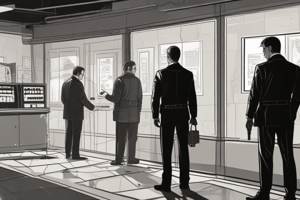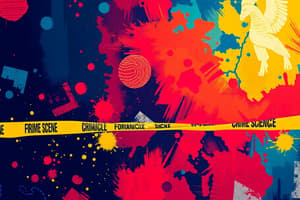Podcast
Questions and Answers
What is physical evidence? List some examples.
What is physical evidence? List some examples.
Physical evidence is any object or item that has relevance to the crime, such as fingerprints, hair, fibers, soil, documents, blood, DNA, glass, metals, powders, pills, etc.
In addition to the location where the crime was committed, what other places may be considered part of the crime scene?
In addition to the location where the crime was committed, what other places may be considered part of the crime scene?
Anywhere evidence that may help explain events can be found.
How does the investigator decide which evidence at the crime scene is significant and which evidence is not?
How does the investigator decide which evidence at the crime scene is significant and which evidence is not?
From experience and knowledge of processing crime scenes.
What is the first step taken in processing a crime scene?
What is the first step taken in processing a crime scene?
List four methods of documenting a crime scene.
List four methods of documenting a crime scene.
Why take notes at a crime scene if photos are taken?
Why take notes at a crime scene if photos are taken?
What information can a sketch give that a photo does not?
What information can a sketch give that a photo does not?
Discuss one type of search method and where it may be used.
Discuss one type of search method and where it may be used.
Where does the questioned evidence come from?
Where does the questioned evidence come from?
Where do the controls come from?
Where do the controls come from?
What type of evidence should be collected from the crime scene?
What type of evidence should be collected from the crime scene?
Make a list of the controls that would need to be collected in this case for comparison.
Make a list of the controls that would need to be collected in this case for comparison.
Discuss the type of packaging that should be used for each type of evidence in the scene. Explain your reasoning.
Discuss the type of packaging that should be used for each type of evidence in the scene. Explain your reasoning.
Why is it important to maintain the chain of custody?
Why is it important to maintain the chain of custody?
What steps should be taken in this case to maintain the chain of custody?
What steps should be taken in this case to maintain the chain of custody?
Flashcards are hidden until you start studying
Study Notes
Physical Evidence
- Physical evidence refers to objects relevant to a crime, including fingerprints, hair, fibers, soil, documents, blood, DNA, glass, metals, powders, and pills.
Crime Scene Locations
- Besides the primary crime scene, any locations where informative evidence may be found are part of the investigation.
Determining Evidence Significance
- Investigators assess evidence significance based on experience and knowledge regarding crime scene processing.
Initial Crime Scene Processing Step
- The first action taken in processing a crime scene is to isolate and secure the area.
Crime Scene Documentation Methods
- Documentation methods include taking notes, creating sketches, capturing photos, and recording videos.
Importance of Note-Taking
- Note-taking enhances observer attentiveness and captures details such as names, dates, and locations that photos might miss.
Importance of Sketches
- Sketches provide perspective, layout, and dimensions of the scene, which cannot be fully conveyed through photographs.
Evidence Source
- Questioned evidence originates directly from the crime scene.
Control Evidence Sources
- Control evidence comes from known sources, including samples from the victim and suspects.
Evidence Collection
- Types of evidence to be collected include blood, soil, glass, fingerprints, hair, fibers, and notes.
Controls for Comparison
- Controls to be collected for comparison include samples from both the victim and any suspects involved.
Packaging Evidence
- Appropriate packaging includes:
- Fingerprints: dusted and lifted using tape
- Broken glass: stored in a rigid container
- Soil, fibers, hair, notes: placed in envelopes or vials
- Blood: dried and stored in a freezer
Chain of Custody Importance
- Maintaining the chain of custody is crucial to uphold the integrity of evidence for court proceedings.
Steps to Maintain Chain of Custody
- Document who had contact with the evidence and the timeline, ensuring all items are properly sealed.
Studying That Suits You
Use AI to generate personalized quizzes and flashcards to suit your learning preferences.




